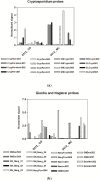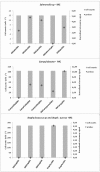Detection of emerging and re-emerging pathogens in surface waters close to an urban area
- PMID: 26006125
- PMCID: PMC4454982
- DOI: 10.3390/ijerph120505505
Detection of emerging and re-emerging pathogens in surface waters close to an urban area
Erratum in
- Int J Environ Res Public Health. 2015 Oct;12(10):13413-4. Baudart-Lenfant, Julia [added]
Abstract
Current knowledge about the spread of pathogens in aquatic environments is scarce probably because bacteria, viruses, algae and their toxins tend to occur at low concentrations in water, making them very difficult to measure directly. The purpose of this study was the development and validation of tools to detect pathogens in freshwater systems close to an urban area. In order to evaluate anthropogenic impacts on water microbiological quality, a phylogenetic microarray was developed in the context of the EU project µAQUA to detect simultaneously numerous pathogens and applied to samples from two different locations close to an urban area located upstream and downstream of Rome in the Tiber River. Furthermore, human enteric viruses were also detected. Fifty liters of water were collected and concentrated using a hollow-fiber ultrafiltration approach. The resultant concentrate was further size-fractionated through a series of decreasing pore size filters. RNA was extracted from pooled filters and hybridized to the newly designed microarray to detect pathogenic bacteria, protozoa and toxic cyanobacteria. Diatoms as indicators of the water quality status, were also included in the microarray to evaluate water quality. The microarray results gave positive signals for bacteria, diatoms, cyanobacteria and protozoa. Cross validation of the microarray was performed using standard microbiological methods for the bacteria. The presence of oral-fecal transmitted human enteric-viruses were detected using q-PCR. Significant concentrations of Salmonella, Clostridium, Campylobacter and Staphylococcus as well as Hepatitis E Virus (HEV), noroviruses GI (NoGGI) and GII (NoGII) and human adenovirus 41 (ADV 41) were found in the Mezzocammino site, whereas lower concentrations of other bacteria and only the ADV41 virus was recovered at the Castel Giubileo site. This study revealed that the pollution level in the Tiber River was considerably higher downstream rather than upstream of Rome and the downstream location was contaminated by emerging and re-emerging pathogens.
Keywords: concentration of water, urban areas; emerging and re-emerging microorganisms; environmental water sample; oligonucleotide microarrays; q-PCR.
Figures








Similar articles
-
The River Ruhr - an urban river under particular interest for recreational use and as a raw water source for drinking water: The collaborative research project "Safe Ruhr" - microbiological aspects.Int J Hyg Environ Health. 2016 Oct;219(7 Pt B):643-661. doi: 10.1016/j.ijheh.2016.07.005. Epub 2016 Jul 14. Int J Hyg Environ Health. 2016. PMID: 27495908
-
The impact of anthropogenic pressure on the virological quality of water from the Tiber River, Italy.Lett Appl Microbiol. 2017 Oct;65(4):298-305. doi: 10.1111/lam.12774. Epub 2017 Aug 20. Lett Appl Microbiol. 2017. PMID: 28708249
-
Elucidating Waterborne Pathogen Presence and Aiding Source Apportionment in an Impaired Stream.Appl Environ Microbiol. 2018 Mar 1;84(6):e02510-17. doi: 10.1128/AEM.02510-17. Print 2018 Mar 15. Appl Environ Microbiol. 2018. PMID: 29305503 Free PMC article.
-
A review on recent progress in the detection methods and prevalence of human enteric viruses in water.Water Res. 2018 May 15;135:168-186. doi: 10.1016/j.watres.2018.02.004. Epub 2018 Feb 8. Water Res. 2018. PMID: 29471200 Review.
-
Towards a unified system for detecting waterborne pathogens.J Microbiol Methods. 2003 May;53(2):185-97. doi: 10.1016/s0167-7012(03)00023-x. J Microbiol Methods. 2003. PMID: 12654490 Review.
Cited by
-
Public health risks associated with hepatitis E virus (HEV) as a food-borne pathogen.EFSA J. 2017 Jul 11;15(7):e04886. doi: 10.2903/j.efsa.2017.4886. eCollection 2017 Jul. EFSA J. 2017. PMID: 32625551 Free PMC article.
-
Experimental Protocol for Detecting Cyanobacteria in Liquid and Solid Samples with an Antibody Microarray Chip.J Vis Exp. 2017 Feb 7;(120):54994. doi: 10.3791/54994. J Vis Exp. 2017. PMID: 28287562 Free PMC article.
-
Isolation and characterization of a multidrug-resistant Clostridioides difficile toxinotype V from municipal wastewater treatment plant.J Environ Health Sci Eng. 2020 Sep 26;18(2):1281-1288. doi: 10.1007/s40201-020-00546-0. eCollection 2020 Dec. J Environ Health Sci Eng. 2020. PMID: 33312642 Free PMC article.
-
Impact of urban contamination of the La Paz River basin on thermotolerant coliform density and occurrence of multiple antibiotic resistant enteric pathogens in river water, irrigated soil and fresh vegetables.Springerplus. 2016 Apr 22;5:499. doi: 10.1186/s40064-016-2132-6. eCollection 2016. Springerplus. 2016. PMID: 27186463 Free PMC article.
-
Seasonal dynamics of freshwater pathogens as measured by microarray at Lake Sapanca, a drinking water source in the north-eastern part of Turkey.Environ Monit Assess. 2017 Dec 22;190(1):42. doi: 10.1007/s10661-017-6314-7. Environ Monit Assess. 2017. PMID: 29273852
References
-
- Brunkard J.M., Ailes E., Roberts V.A., Hill V., Hilborn E.D., Craun G.F., Rajasingham A., Kahler A., Garrison L., Hicks L., et al. Surveillance for waterborne disease outbreaks associated with drinking water—United States, 2007–2008. MMWR Surveill. Summ. 2011;60:38–68. - PubMed
-
- Marcheggiani S., Carere M., Della Bella V., Grifoni R., Funari E., Mancini L. Epidemie veicolate dall’acqua. In: Sinisi L., editor. Cambiamenti Climatici e Salute: Criticità e Proposte Progettuali per una Strategia D’adattamento Ambientale. ISPRA; Rome, Italy: 2010. pp. 25–35. (In Italian)
Publication types
MeSH terms
LinkOut - more resources
Full Text Sources
Other Literature Sources

